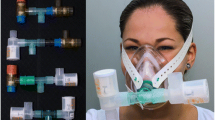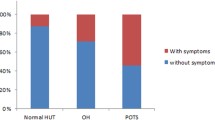Abstract
The haemodynamic effects of head-up tilt (HUT) at different tilt angles were investigated non-invasively in eight normal male subjects. Mean arterial pressure (MAP; by Ohmeda Finapres 2300), stroke volume (SV) and heart rate (HR; by BoMed NCCOM3-R7S) were continuously recorded whilst performing a series of HUTs (55°, 10°, 20°, 30° and 55°) lasting 3 min each. The response to HUT was proportional to the sine of the tilt angle. The magnitude of the response varied between subjects. HUT to 55° resulted in mean (95% confidence limits) increases in MAP by 16 (±16)% and HR by 11 (±24)% and a decrease in SV by −25 (±22)%. These results were repeatable after 30 min. At small tilt angles, i.e. ≤20°, MAP did not change and HR decreased by −3 (±4)%. A detailed analysis revealed immediate dynamic (0–30 s), late dynamic (30–90 s) and plateau (after 90 s) phases in the response to HUT. In conclusion, HUT produces reproducible haemodynamic effects, although differences exist among subjects. A detailed analysis of these effects can be successfully performed using non-invasive methods.
Similar content being viewed by others
References
de Mey C, Enterling D. Assessment of the hemodynamic response to single passive head-up tilt by non-invasive methods in normotensive subjects.Methods Find Exp Clin Pharmacol 1986;8: 449–457.
Blomqvist CG, Stone HL. Cardiovascular adjustments to gravitational stress. In: American Physiology Society, eds.Handbook of Physiology: The Cardiovascular System. Baltimore: Williams and Wilkins, 1983; 1025–1063.
BoMed Ltd. Prepare the patient. In: BoMed Ltd. eds.NCCOM3R7S Cardiodynamic Monitor Operator's Manual. Irvine, CA: BoMed Ltd, 1991; 15–17.
Imholz BP, van Montfrans GA, Settels JJ, van der Hoeven GM, Karemaker JM, Wieling W. Continuous non-invasive blood pressure monitoring: reliability of Finapres device during the Valsalva manoeuvre.Cardiovasc Res 1988;22: 390–397.
Bernstein DP. A new stroke volume equation for thoracic electrical bioimpedance: theory and rationale.Crit Care Med 1986;14: 904–909.
Bland JM, Altman DG. Statistical methods for assessing agreement between two methods of clinical measurement.Lancet 1986;i: 307–310.
Shannon RP, Maher KA, Santinga JT, Royal HD, Wei JY. Comparison of differences in the hemodynamic response to passive postural stress in healthy subjects greater than 70 years and less than 30 years of age.Am J Cardiol 1991;67: 1110–1116.
Vaz M, Kumar MV, Rodrigues D, Kulkarni RN, Shetty PS. Variability in cardiovascular and plasma norepinephrine responses to head-up tilt in healthy human subjects.J Auton Nerv Syst 1991;36: 201–208.
Hainsworth R, Al-Shamma YM. Cardiovascular responses to upright tilting in healthy subjects.Clin Sci 1988;74: 17–22.
Matalon SV, Farhi LE. Cardiopulmonary readjustments in passive tilt.Appl Physiol 1979;47: 503–507.
Tuckman J, Shillingford J. Effect of different degrees of tilt on cardiac output, heart rate and blood pressure in normal man.Br Heart J 1966;28: 32–39.
de Mey C, Enterling D. Variant responses impair the usefulness of passive upright tilt in drug research.Methods Find Exp Clin Pharmacol 1988;10: 57–64.
de Mey C, Enterling D, Brendel E, Meineke I. Postprandial changes in supine and erect heart rate, systemic blood pressure and plasma noradrenaline and renin activity in normal subjects.Eur J Clin Pharmacol 1987;32: 471–476.
Parati G, Casadei R, Groppelli A, Di Rienzo M, Mancia G. Comparison of finger and intra-arterial blood pressure monitoring at rest and during laboratory testing.Hypertension 1989;13: 647–655.
Van Egmond J, Hasenbos M, Crul JF. Invasive v. non-invasive measurement of arterial pressure. Comparison of two automatic methods and simultaneously measured direct intra-arterial pressure.Br J Anaesth 1985;57: 434–444.
Critchley LA, Short TG, Gin T. Hypotension during subarachnoid anaesthesia: haemodynamic analysis of three treatments.Br J Anaesth 1994;72: 151–155.
Sanders DJ, Jewkes CF, Sear JW, Verhoeff F, Foex P. Thoracic electrical bioimpedance measurement of cardiac output and cardiovascular responses to the induction of anaesthesia and to laryngoscopy and intubation.Anaesth 1992;47: 736–740.
Thomas SH. Impedance cardiography using the Sramek-Bernstein method: accuracy and variability at rest and during exercise.Br J Clin Pharmacol 1992;34: 467–476.
Vohra A, Thomas AN, Harper NJ, Pollard BJ. Non-invasive measurement of cardiac output during induction of anaesthesia and tracheal intubation: thiopentone and propofol compared.Br J Anaesth 1991;67: 64–68.
Bernstein DP. Noninvasive cardiac output measurement. In: Shoemaker WC, ed.Textbook of Critical Care. London: Saunders, 1989; 159–185.
Gotshall RW, Wood VC, Miles DS. Comparison of two impedance cardiographic techniques for measuring cardiac output.Ann Biomed Engineer 1989;17: 495–505.
Wong DH, Tremper KK, Stemmer EA et al. Noninvasive cardiac output: simultaneous comparison of two different methods with thermodilution.Anesthesiology 1990;72: 784–792.
Young JD, McQuillan P. Comparison of thoracic electrical bioimpedance and thermodilution for the measurement of cardiac index in patients with severe sepsis.Br J Anaesth 1993;70: 58–62.
Coonan TJ, Hope CE. Cardio-respiratory effects of change of body position.Can Anaesth Soc J 1983;30: 424–438.
Author information
Authors and Affiliations
Corresponding author
Rights and permissions
About this article
Cite this article
Critchley, L.A.H., Conway, F., Anderson, P.J. et al. Non-invasive continuous arterial pressure, heart rate and stroke volume measurements during graded head-up tilt in normal man. Clinical Autonomic Research 7, 97–101 (1997). https://doi.org/10.1007/BF02267754
Received:
Accepted:
Issue Date:
DOI: https://doi.org/10.1007/BF02267754




